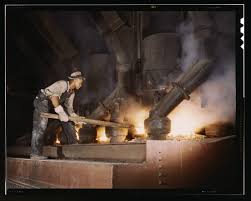What is smelting?« Back to Questions List
|
We use a lot of things at home and elsewhere which are made of metals. For example, common tools, kitchen utensils, your car, juice cans, gold rings etc. We know that all these objects are made of metals. But where do we get these metals from? These metals are provided by the nature in the form of ores in the earth’s crust. Ores are naturally occurring rocks that contain metals or their compounds like metal oxides in sufficient concentration. The process of extraction of metal from their corresponding ore is called smelting.
Smelting involves partial melting of the ore. Smelting techniques vary depending on the nature of the metal to be extracted. For example, reactive metals are extracted using electricity and less reactive ones are extracted by reduction with carbon. We will discuss about smelting technique of aluminium. Aluminium is one of the most abundant elements and the ore from which it is extracted is called bauxite. Since it is a highly reactive metal, it tends to bond with other elements forming compounds. As such there are about 270 minerals in earth’s crust that contains compounds of aluminium. Bauxite contains not only aluminium oxide but iron oxide as well. In order to separate aluminum oxide from the iron oxide, a technique called Bayer process is used. In the Bayer process, bauxite is mixed with an inorganic compound called caustic soda (sodium hydroxide) and heated under pressure. The sodium hydroxide dissolves the aluminum oxide, forming sodium aluminate. The iron oxide remains solid and is separated by filtration. Now, aluminum hydroxide is added to the liquid sodium aluminate to cause aluminum oxide to separate from the solution as a solid. These crystals are washed and heated to get rid of the water. The result is pure aluminum oxide, a fine white powder also known as alumina. Aluminium is further extracted from alumina using the process of electrolysis. Electric current is passed through liquid molten cryolite (or sodium aluminium fluoride), in which alumina has been dissolved. The corresponding oxidation and reduction that occurs at the electrical anode and cathode converts the aluminum oxide into pure aluminum.
Travel sickness (motion sickness): Know the reasonsCommon alloys in everyday life |

